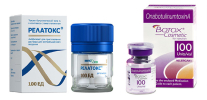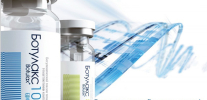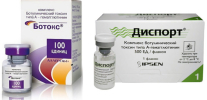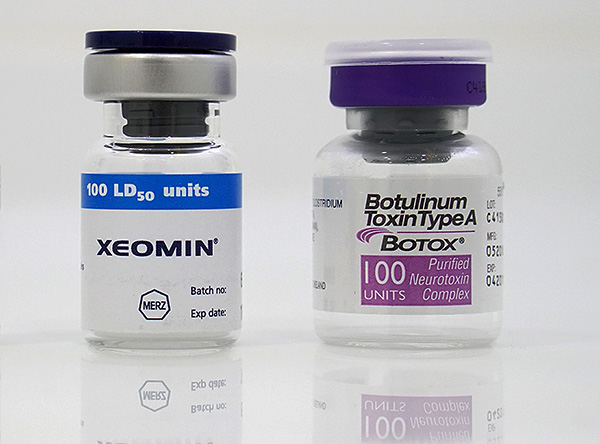
Botox and Xeomin are botulinum toxin preparations used in clinical practice and cosmetology with the same goals: for the treatment of diseases associated with muscle hypertonicity and for the elimination of so-called dynamic wrinkles on the face and other parts of the body.
Both of these drugs are analogues of each other. They are used in similar cases and are largely interchangeable: all the results that are achieved using Botox can be obtained with the help of Xeomin, and vice versa. It is impossible to unequivocally state that one of these drugs is better than the other - there are differences between them (we will talk more about them in more detail), but they are insignificant and do not give one remedy a clear advantage over another. The difference between these tools is well understood by specialists, but for the end user - the patient of the cosmetology clinic - it is not significant.
Botox is manufactured by Allergan, whose production facilities are located in several countries around the world. Specifically, a drug manufactured in Ireland is supplied to Russia.
Xeomin (Xeomin) - a drug manufactured by Merz Pharmaceuticals, Germany. It began to be produced later than Botox, and then when it already gained worldwide fame. This is partly why Kseomin is often considered a “substitute” for Botox, which is wrong: it is a completely independent drug that does not have any obvious shortcomings or noticeable advantages over the Allergan product.
Interestingly, for Allergan, the production of Botox is the main activity. And although today the company has already turned into a large concern, producing, in addition to Botox, many other medicines and cosmetics, however, it was with botulinum toxin that its history began and its production is best known today.
Merz Pharma has never specialized only in cosmetics, and is known as a large manufacturer of various medicines.
Nevertheless, it was in the production and sale of botulinum toxin preparations that these two companies became competitors of each other. Perhaps that is why the prices for both funds are approximately the same.
What is the difference between their products, which one should be chosen to eliminate wrinkles, and is it worth making any difference at all? Let's figure it out ...
Differences in the composition of funds
The active substance of both Botox and Xeomin is botulinum toxin (botulinum toxin) type A. This substance, when introduced into the muscle fiber, inactivates the transmission of nerve impulses to it and thereby contributes to the complete relaxation of the muscle. As a result, wrinkles that are initially formed in places of constant tension of the facial muscles of the face are smoothed out.
An important difference in the composition of these drugs is the structure of the active substance:
- In Botox, the active component is a complex complex of botulinum toxin and several proteins associated with it. Such a composite was created to increase the stability of the active substance and, presumably, to enhance its action;
- Xeomin contains botulinum toxin in its pure form without associated proteins. Perhaps this is the main difference between these tools.
On a note
However, studies have shown that the compositional structure of the Botox molecule in body tissues does not differ in stability from the molecule of pure botulinum toxin in Xeomin.
Today, there are suggestions that the size of the molecules of the active substances of botulinum toxin preparations affects the speed of their diffusion into the muscle at the injection site, as well as the size of the area to which the effect of the drug administered during one injection extends.Such ideas are well-founded: the larger the molecule, the more difficult it is to move in the intracellular space and the less likely it will move from one muscle to another.
On this basis, for a long time it was believed that Botox acts more precisely, and Xeomin can "spread" around the injection site, immobilizing neighboring muscles, including those whose inactivation is undesirable. This phenomenon was sometimes even called the cause of ptosis of the upper eyelid: they say that Kseomin quickly passes from the muscle of the proud (Musculus procerus) into the circular muscle of the eye, which leads to the omission of the eyelid.
The following photo shows a typical example:
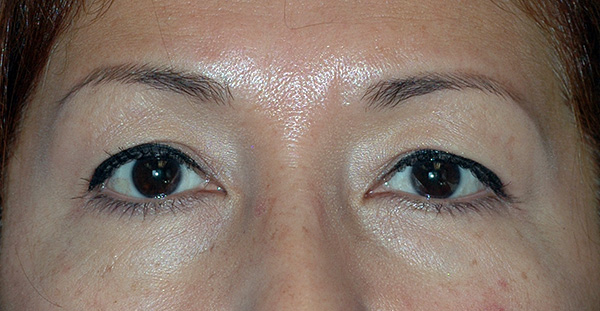
In rare cases, with botulinum toxin injections, drooping of the eyelids of one of the eyes (ptosis) can be observed, which leads to some asymmetry of the face.
For the same reason, it was believed that after the introduction into the muscle, Xeomin acts faster - on the first day, and Botox - only for 3-4 days. But the Botox effect, presumably, persists for a longer period.
The experiments and studies showed that there is no significant difference either in the distribution rate in the tissues or in the diffusion region between the agents. Both Botox and Xeomin with equal dilutions act the same on a similar area, and the effect of their introduction appears at identical intervals. The difference in effects in different cases is almost always due to errors or differences in the procedures or different dilutions of the preparations.
The absence of differences in the effectiveness of the drugs is due to the fact that when Botox botulinum complex gets into the tissues, it immediately decomposes into botulinum toxin and auxiliary proteins, and after that the active substance of the drug does not differ from that in Xeomin.
Differences in dilutions (dosages) of drugs
To obtain the same cosmetic (or therapeutic) result, almost the same dosages of Botox and Xeomin are required.
In the bottle of each drug contains the so-called lyophilisate - a dry substance containing, in fact, the active substance and auxiliary components. Since it is difficult to measure the mass of botulinum toxin itself in the preparation due to its very small amount, the number of units of biological effectiveness of the agent is indicated on the bottle.
In vials of Xeomin and Botox, the content of botulinum toxin may be 50 or 100 units.
On a note
1 unit of botulinum toxin is a dose capable of killing a mouse weighing 18-20 g with a 50% probability. The same dose for a person is about 3,500 times greater. Therefore, a bottle with 100 IU of the product does not pose a significant threat to human health even with the most serious violations in its use (for example, when using the product inside).
100 IU of the Botox active substance have the same activity as 100 IU of the active substance Xeomin. A lot of experiments were carried out to study the effectiveness of these substances - some of them showed some difference in the activity of the drugs, but the weighted average result of such experiments showed a ratio of the activity of these drugs at about 1: 1.
It is interesting
For comparison: the activity of 1 U of Botox or 1 U of Xeomin is approximately equivalent to the activity of 2.67 U of Disport. To simplify the calculation of concentration, doctors use 2.5 times more Dysport units for injection than Botox or Xeomin to get the same effect.
For this reason, to obtain the same effect, the dry powder of Botox and Xeomin is diluted with the same amounts of saline. These dilutions themselves may vary, depending on which muscle the drug is injected into and what effect it is planned to obtain, but under the same conditions, the same amount of diluent is used to obtain the same result.
The standard working ranges for dilution of Botox and Xeomin are 1-8 ml for the contents of one bottle per 100 PIECES to obtain a concentration of 12.5-100 units per 1 ml of solution for injection.
On a note
Dysport, corresponding to its activity, is diluted in the range of 300 PIECES per 0.6-2.5 ml with a final concentration of 120-500 PIECES / ml.
Xeomin and Botox injection efficacy
As noted above, experimental studies have not revealed significant differences between the efficacy of Botox and Xeomin.

In practice, there is no significant difference between the effectiveness of Botox and Xeomin.
Both drugs at the same dilutions have a similar effect and inactivate the injected muscles equally. There are no situations where, for example, after Botox injection, complete muscle relaxation and smoothing of wrinkles would be achieved, and after Xeomin's injection, muscle tone would not disappear, or vice versa. In all cases in which one of these means operates, the second works with the same efficiency.
On a note
The FDA (U.S. Food and Drug Administration) considers Xeomin and Botox to be the equivalent for eliminating facial wrinkles. FDA experts note that both drugs are equally effective, including when used outside the scope of the indications established by the FDA.
Some doctors have personal preferences and often use either Botox or Xeomin. Sometimes they justify their choice with the alleged strength of the drug, stating that one of these drugs is more effective and gives a more pronounced result. Such opinions are largely subjective and to a large extent reflect the doctor’s habit of working with this or that tool.
Feedback:
“I was most afraid of injections that there would be no effect. I was ready to sit at home for several days, I was ready for side effects, but I really wanted to remove the frontal wrinkles. I decided to do it. I did it. All fears are in vain, wrinkles really disappeared, and even faster than I thought. Already on the third day, the forehead smoothed out! But there were no violations in the facial expressions. Eyebrows rose, and if necessary, they frowned. After the injections, there are no dots left; she could barely see them in the mirror. Kolola Botox, although she read somewhere that Xeomin is stronger, but the doctor told me that there was no difference. After the first time, the effect persists for 6-7 months, after subsequent procedures longer. Somewhere after the fifth time you can stab once a year, this will be enough. ”
Julia, from correspondence on the forum
The speed of the onset of the effect and its duration
Although there is an opinion, Xeomin acts faster, and the effect of Botox lasts longer, there is no actual evidence of these assumptions. In experiments with strict control of drug dosages and the results obtained, both the rate of onset of the effect and its duration turned out to be identical.
The rate of manifestation of the effect after injection of drugs is almost the same. According to special studies, the complete smoothing of wrinkles of the nose is manifested when Botox is used on the third or fourth day after injection, when using Xeomin on average on the third day.
The photo below shows the effect of using Xeomin to smooth out glabellar wrinkles:
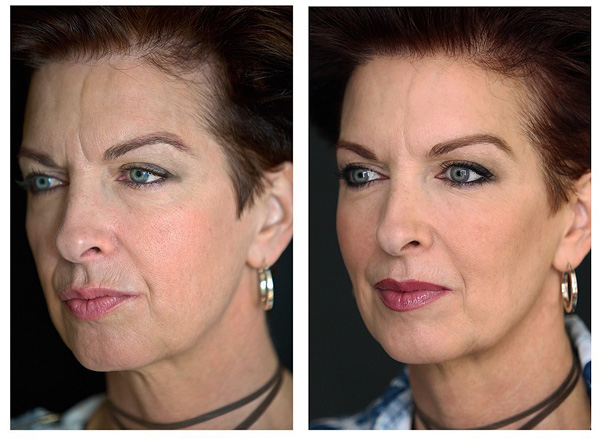
An example of smoothing eyebrow wrinkles with Botox.
The effect of eliminating wrinkles persists when using Botox for 127-150 days, with Xeomin - for 130-142 days. That is, these indicators for drugs are almost identical (within the experimental error).
On a note
The duration of action of funds may vary depending on the individual characteristics of the body. In some people, the effect of botulinum therapy comes faster and lasts longer, in others, on the contrary, it can be slower and shorter.However, in the same patient, two different botulinum toxin preparations act on the muscles of the face and wrinkles almost identically.
Possible side effects from injections of these drugs
Due to the almost identical effect on the muscles of the face and other parts of the body, local side effects from the use of Botox and Xeomin practically do not differ. Such phenomena may be observed as:
- Blepharoptosis (drooping eyelids);
- Disorders of facial expressions;
- Violations of the symmetry of muscle contraction of the face;
- "Mephistopheles eyebrows" and similar defects arising from an incorrect assessment of the interaction of the facial muscles of the patient;
- Difficulty swallowing (dysphagia);
- Difficulties in articulating and pronouncing individual sounds.
All of them in most cases are caused not by the unforeseen effect of the drug, but by errors in the technique of its administration and in the selection of dosages. Moreover, with such errors, side effects with the same strength and probability are manifested both when using Botox and when using Xeomin.

As a rule, the probability of side effects during botulinum therapy is determined not by the drug used, but by errors by the cosmetologist and the individual characteristics of the patient's body.
Also, more than half of the cases of side effects are associated with a violation by the patients themselves of the rules for recovery after the procedures. People take hot baths, rub their face, can take alcohol, do not warn the doctor about taking certain drugs shortly before the procedures. In such cases, indeed, it may seem that one drug caused side effects (when violations were committed, but the patient did not pay attention to them), and the use of another was without problems.
However, with strict monitoring of both the introduction of funds and the behavior of patients before and after the procedure, the researchers did not find differences in the incidence of adverse reactions.
Feedback
“For the first time, Botox was injected into the brow muscle and the muscles on the sides of the eyes. I was satisfied with the effect, but the second time the doctor suggested I inject Xeomin. It seems to be a little more expensive, but safer. I trust her, that's why I did it. She noticed an important difference: weak muscles are immobilized normally and for a long time (where the wrinkles are small), and strong ones (for example, between the eyebrows) after Xeomin restore activity faster. Between the eyebrows after Xeomin, a fold appeared in me after 2.5 months - very quickly compared to 6 months for Botox. Therefore, for the future I made a decision: to chip small wrinkles with Xeomin, and large ones only with Botox ... "
Alena, Moscow
The immunogenicity of both agents is also almost the same. There is reason to believe that Botox can often cause allergic reactions, or addiction to it develops faster due to the presence of more complex proteins in its composition. It is known that the more substances foreign to the body are present in the preparation, the greater the probability that the immune system will develop resistance to at least one of them or respond to at least one of them with a hypersensitivity reaction (allergy).
However, in reality, there was no difference in the frequency of allergies or addiction to Botox and Xeomin.
Today it is known that blocking antibodies to Botox components are produced in approximately 5% of patients in whom the procedures were performed 2 times or more.
According to Kseomin, there are no official data of this kind yet.
A significant difference between the drugs is that Xeomin can be stored at a temperature of + 25 ° C, and Botox can only be stored refrigerated at + 4 ° C. This means that when using Xeomin, the risk that the drug was stored incorrectly will be less (sometimes, because of this, the effectiveness decreases).However, in reality this is not an important criterion: cases of violation of the rules for storage of funds are very rare, and special studies have not shown a decrease in the quality and effectiveness of Botox neither in case of accidental violations of the temperature regime of storage, nor during storage of an already restored product (which is prohibited by the FDA).
Some experts are less willing to use Xeomin as a newer and less studied drug. However, the studies conducted on it showed that its safety profile is no different from the safety profile of Allergan's product.
On a note
In this regard, both Botox and Xeomin are more preferable than newer products - Neuronox (Korea), Purtox (USA), Prosigne (China), which, although they have some experimental base, are not so well researched that their safety could be unequivocally recognized as a similar safety to Botox or Xeomin.
The difference in prices for Botox and Xeomin
Prices for these two drugs vary slightly in favor of Botox.
So, you can buy a Botox bottle for 100 units for an average of 12,000 rubles. A bottle of Xeomin per 100 units costs an average of 12800-13000 rubles.
In this case, it is necessary to take into account such nuances:
- In one procedure, the doctor uses, as a rule, only part of the bottle. For example, 17-20 units of the drug are used to eliminate eyebrow wrinkles, 30-35 units to eliminate “crow's feet”. Consequently, the cost of the drug for a particular procedure is usually less than the price of a full bottle, which means that the difference in cost will also be less;
- A significant part of the cost of the procedure is the reward to the cosmetologist. It is the same regardless of whether the doctor uses Xeomin, or Botox.
Thus, the final cost of botulinum therapy with both drugs is either the same (the doctor compensates for the difference in the price of the tool by drawing up a price list by paying for his own labor), or the difference in cost relative to the full price of the procedure itself will be insignificant.
As a result, for the patient, there is no significant difference between Xeomin and Botox. All other things being equal (the same doctor, equally strict adherence to the instructions for administering the drug and restrictions after the procedure), the effectiveness and safety of injections of these drugs will be the same, and if the cost varies, the difference will be small.
It is possible to replace one of these drugs with another. All the differences between these tools may be significant for specialists and manufacturers, but not for the end user.
Comments by a cosmetologist about Xeomin’s injections in the forehead, eyebrows and corners of the eyes

